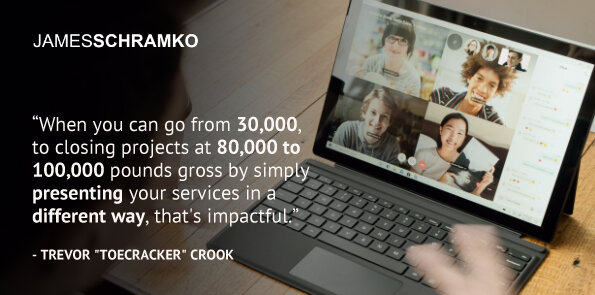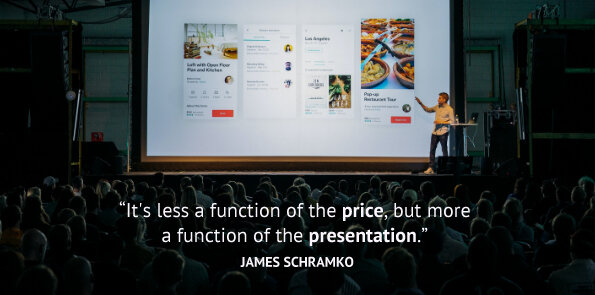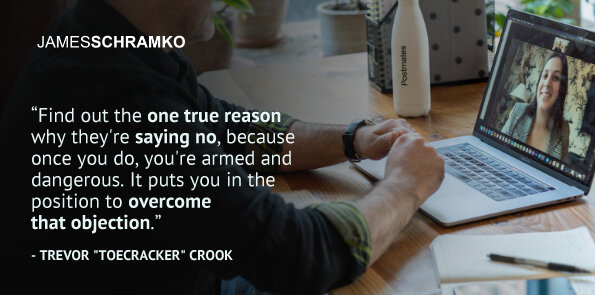Podcast: Download (Duration: 45:00 — 42.0MB)
Get Notified Of Future Episodes Apple Podcasts | Spotify | Amazon Music | Android | Blubrry | Gaana | TuneIn | Deezer | Anghami | RSS | More
A good proposal, especially for high-ticket offerings, can increase your sales and give you the backing you need to raise your prices.
Trevor “Toecracker” Crook has achieved both results for numerous clients, and returns to talk about his proposal system.
He and James discuss just what an effective proposal contains.
They talk about the leverage that proof and good probing provide.
And Trevor shares stories of his best successes.
Table of contents
1. Defining a proposal system
2. Handling the price question
3. James’s experience with proposals
4. Can people lose interest?
5. Two examples of increased conversions
6. The pros of doing proposals
7. Proposals as a game-changer
8. Because the system was “too salesy”
9. When students don’t want the risk
10. A parallel with James’s methods
11. The lengthy document with sales elements
12. Are multiple packages a good idea?
13. Why have a time limit?
14. Pinning down the real reason for No
15. When you find a great supplier…
16. The understated approach to achievement
17. Getting your hands on Trevor’s proposal
Defining a proposal system
Some people, says James, have a proposal system, and may not need it. Other don’t have one and need it.
Trevor’s proposal system originated from his banking experience, where proposals were necessary for decision-making. He adapted this approach when he got into copywriting, providing comprehensive proposals after talking to clients.
Trevor’s proposals contain all the information relevant to an informed sales decision, – elements like positioning, proof, pricing, risk reversal, and testimonials.
Handling the price question
What’s interesting is that Trevor avoids price discussion on calls, which he acknowledges is a common concern for many people.
His approach involves a vetting process to ensure mutual value before discussing fees. After a call, he says to James, he will review the discussion and determine the client’s needs, aligning it with his own evaluation.
Trevor then promises to include all the needed information, including his fees, in a proposal, to inform the decision-making process. This approach has proven effective – he has never encountered objections when explaining it to clients.
James’s experience with proposals
James’s experience with proposals started with a flawed system he once used in the car industry. He would willingly provide written details on a vehicle to customers, never to hear from them again – his notes would go to serve as a bargaining tool with competitors.
Since then, James has avoided using proposals in his business and found alternative ways to handle pricing discussions during conversations. He touches on the negative practice of pressuring clients to make immediate decisions by offering discounted rates on a call – this he strongly disapproves of.
Instead, James adopted a workaround where he would write notes on non-photocopyable blue paper, and explain to clients that these were his personal notes – if they wanted a copy, he would gladly provide an order form for them to consider. This bridging approach helped transition the conversation into the order phase, although face-to-face meetings were often preferred for the actual sales process.
Can people lose interest?
These days, conversations with prospects are likely to be via Zoom or phone, even text. Is there any concern, asks James, that the time gap between the conversation and the proposal’s delivery (24 to 48 hours) might lead to a decay in interest?
Trevor stresses the efficiency of his template-based approach, which allows him to make quick adjustments and send the proposal promptly, often within 24 hours. The conversations he has with prospects, he says, already involve a significant amount of proof and qualification, leading to a high closing rate of 85% to 90% for his own projects, and similar success for copywriters he has mentored.
Trevor’s proposal system in essence acts as a leverage tool, streamlining the conversion process. It’s actually enabled copywriters to double their fees within the first three months while taking on fewer clients or maintaining the same workload.
Two examples of increased conversions
To back this up, Trevor shares two stories of clients who implemented his proposal system and experienced significant increases in conversions.
The first client had a sideline business in the B2C market and was struggling with low conversion rates. After Trevor suggested using a proposal and changing the way they presented their pricing and offer, the client reported a 260% increase in conversions within 90 days, without any changes to their ad budget or lead generation.
The second example involves a pain consultant who was treating Trevor. Although Trevor took on his services, he found the consultant’s proposal and offer to be lacking – sucked was his word. He proposed a deal where he would teach the consultant his system in exchange for a partial refund.
Prior to using the system, the consultant had a conversion rate of 15%. After refining his proposal with Trevor’s guidance, the conversion rate jumped to 60% within 90 days, a remarkable 400% improvement. On top of that, the consultant was able to raise his fee rates significantly.
The pros of doing proposals
So for someone already doing proposals, there’s a chance they could do them better?
Yes, says Trevor. He suggests that the system is especially suitable for individuals who are not experienced or comfortable with traditional selling methods. It provides a structured approach that can be leaned on to facilitate the conversion process.
They also discuss the applicability of the proposal system to different types of businesses. James mentions his experience selling cars, where competition and commoditization made it challenging to differentiate the product. In contrast, selling unique items like used vehicles or surfboards was easier as they held more value.
Trevor agrees and says the proposal system can be used to augment existing service businesses. It has the potential to become the primary source of conversions or work in conjunction with other conversion methods, depending on the specific business context.
Proposals as a game-changer
Trevor says a proposal system can change the game for businesses in terms of their conversion rates and pricing strategies.
He once spoke with a successful ad agency owner who recognized the potential of Trevor’s system to differentiate his agency and let them command higher prices. Could he get it, he asked? For 25 grand, replied Trevor, or he could wait for the training.
Trevor says he initially underestimated the value of the system, until he started teaching it to others and saw their positive results across various industries.
James agrees with the importance of presenting services in a different way.
He recalls a guest speaker at his event who shared tips on proposal creation, highlighting the availability of digital tools like Quote Roll. This concerned him that over-reliance on tools might lead to focusing on the technical rather than incorporating essential sales elements into proposals.
Because the system was “too salesy”
Trevor shares an anecdote about a female copywriter who initially rejected his proposal system, considering it too salesy and not aligned with her clinical approach.
When this copywriter started experiencing rejections on higher-priced projects, Trevor advised her to try his system. Reluctantly, she agreed, and sent out a modified version of the proposal.
Surprisingly, it was accepted by two prospects – $22,000 worth of projects.
The copywriter shared her story with her email list, admitting her initial resistance and acknowledging the effectiveness of the proposal system.
When students don’t want the risk
Trevor is quite able to close big projects during sales calls, but prefers using his proposal system to minimize the risk involved.
He shares his experience of mentoring students and reviewing their proposals before sending them out to prospects. Some students tend to err on the side of caution by quoting lower fees, anticipating potential negotiations.
Trevor would occasionally increase the fees in their proposals without their knowledge, and to their surprise, the clients would often accept the higher amounts.
The focus is on the presentation rather than the price, says James.
Presentation, Trevor agrees. He emphasizes the importance of incorporating proof and positioning within the proposal, a format he’s used since 2012.
A student of his with good copy skills hated the conversion process, but using Trevor’s system went from $5,000 projects to $10,000 or even $25,000 projects, depending on scope.
Another student closed a $13,500 project, surpassing her previous project fees of a couple to three thousand dollars.
A parallel with James’s methods
James reflects on his own experience with effective sales methods and how they parallel Trevor’s proposal system. His coaching application framework for selling services over the phone has helped clients who initially struggled to make sales, but saw positive results after following the steps.
There’s value, says James, in having a system that works. He’s actually published it as a playbook within his membership.
James mentions the industry’s focus on setters and closers, where prospects are prepared through direct messages before being handed over to a closer for a phone call. He rejects the notion that closing is the most important part of selling – the opening, investigation, and presenting stages, he says, are equally crucial.
James believes that if the earlier stages are done right, the close naturally falls into place, without the need for high-pressure tactics or tricky tie downs.
In relation to proposal systems, James suggests that his own clients who use proposals might frame them as action plans when presenting them to clients. He’s found this creates a more assumptive and forward-moving perspective, indicating that the client will move forward with the proposed plan.
He also notes that incorporating proof elements and logistical details into the action plan has been very successful for his clients who are unaware of Trevor’s proposal system.
The lengthy document with sales elements
Trevor’s proposals are typically long – the proof alone can be 23 to 28 pages. And his previous anecdotes indicate that they contain sales elements. So how does it work, what does it actually look like, asks James?
Before that, Trevor acknowledges James’s point of calling it an action plan. He himself sometimes terms it an invitation.
An invitation sounds lovely, says James. He used to send out a mini version via email detailing what he does, when he’ll do it, what the expected outcomes are, who it’s for and not for.
That got him sales, because he’d already a lot of framing and building up trust through published information.
He’s known other people to do what’s called a Google doc close, a sort of modern proposal. They’d get prospects’ details and share with them a Google doc that is effectively a sales letter summary.
Trevor has used the Google Doc, and plans to test shorter versions in the future, but on highly-qualified people. His usual proposal is long because of the amount of proof in it.
Proof and testimonials build trust and address potential concerns or fears that customers may have.
A vehicle modification company, for instance, recently gained James’s trust through recommendations, a comprehensive website with proof and results, and consistent communication.
James and Trevor agree, a well-crafted proposal with personalized recommendations and supporting evidence can significantly reduce perceived risk and increase customer confidence in making a purchase.
Are multiple packages a good idea?
Does Trevor have multiple packages or
options in his proposal?
Sometimes two, says Trevor.
This is especially effective in situations where different pricing structures or features are involved. Trevor gives an example of copywriters proposing their fees with two options, say a higher fee without royalties or a lower fee with a percentage based on performance.
Similarly, in industries like car modification or landscaping, businesses can provide different package options, such as a good or best bundle.
Trevor shares his experience of using a three-step email sequence to give skeptical landscapers options. By giving a choice between different subscription models, he achieved a high conversion rate.
He also mentions the importance of setting a deadline for decision-making, to create a sense of urgency and avoid missed opportunities.
Why have a time limit?
The time limit in response to proposals needs effective positioning.
Trevor explains that he typically offers a bonus to incentivize quick decision-making, such as an additional session or a guarantee on services. He sends follow-up emails to remind potential clients of the expiration date, and stresses that the decision is ultimately up to them.
Studies by Cialdini, says James, have shown that reminding customers it’s their choice can significantly increase conversions.
Trevor highlights the importance of giving clients the option to ask questions or address any concerns they may have before making a decision. He reassures them that the proposal contains all the necessary information to make an informed choice – the goal is to help clients achieve their desired outcomes.
Pinning down the real reason for No
Old sales school taught that it was good to isolate the price, says James – everything else aside, is it just the price? Is that dangerous, he wonders?
It can be dangerous, says Trevor, without uncovering the real underlying reason behind a prospect’s hesitation. He explains that clients may not always be aware of the true reason, which could be related to trust, uncertainty, or a gut feeling that they can’t articulate.
Trevor shares an example of a client who initially declined his proposal due to doubts about its effectiveness. Through probing, Trevor uncovered this concern and was able to address it by offering a guarantee.
James refers to this as an “assisted sale” and suggests that helping clients navigate their decision-making process can uncover any missing information or gaps.
When you find a great supplier…
Trevor tells of a client who experienced tremendous success from implementing an offer he discussed in a previous podcast episode.
The client’s business flourished, and he afterwards approached Trevor with another project, highlighting the great results of their previous work together.
James shares how he actively seeks out great suppliers and builds strong relationships with them. An example is his surfboard shaper, who James is excited to visit about repairing a snapped surfboard. surfboard.
James values the craftsmanship and reliability of his supplier, and enjoys supporting their business by sending them more customers. Similarly, he anticipates receiving excellent service from a performance car shop he plans to visit, based on the positive reviews he’s heard.
The understated approach to achievement
Will they see the pictures on Facebook? Trevor teases.
Never, says James. He values his privacy and avoids showcasing his personal possessions on social media, preferring to focus instead on delivering content for his clients.
James believes that flashy displays of success are often superficial and that true fulfillment comes from other aspects of life, such as relationships. He appreciates the humble and low-key individuals he encounters, who you’d never suspect are something extraordinary.
Trevor has his own selective approach to sharing on social media, focusing on shoes, travel, and lifestyle.
Getting your hands on Trevor’s proposal
The obvious question, says James, will be how one can get a copy of Trevor’s proposal. Does Trevor teach it anywhere? Is there a course?
Trevor says he’s been offering a “done with you” service, where he works with clients individually, but he is now in the process of creating a course around his methodology. James suggests the possibility of forming a group and promoting Trevor’s course to their audience.
That’s what Trevor’s working on.
People might contact Trevor, receive a proposal for the training, and decide that’s all they need, James jokes.
James cautions against simply copying and pasting people’s frameworks without putting in the necessary work. He stresses the value of understanding the system and customizing it accordingly.
People interested in more from Trevor can find him at Smofo.com, or connect with him on Facebook, facebook.com/toecracker.
Trevor does have plans to provide training and support through a four-session course and a group, as well as offering one-on-one coaching to sharpen the proposal system.
You can also check out more of his guest appearances on the show.
Liked the show? Enjoy all the episodes when you subscribe on iTunes













Leave a Reply